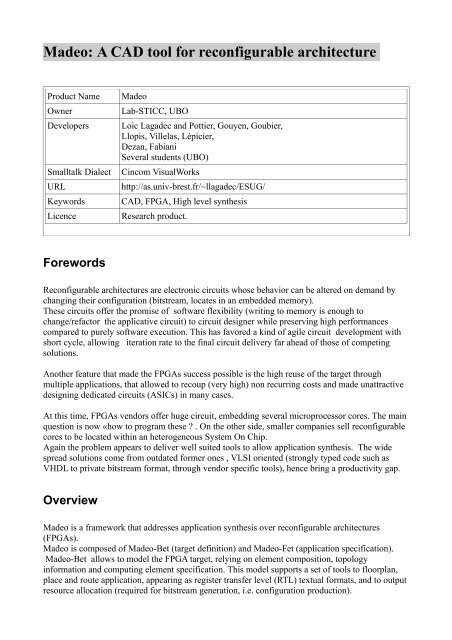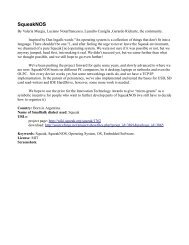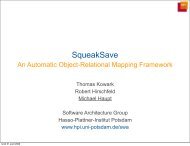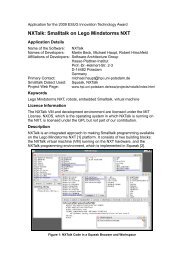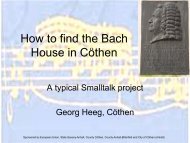Madeo: A CAD tool for reconfigurable architecture
Madeo: A CAD tool for reconfigurable architecture
Madeo: A CAD tool for reconfigurable architecture
Create successful ePaper yourself
Turn your PDF publications into a flip-book with our unique Google optimized e-Paper software.
<strong>Madeo</strong>: A <strong>CAD</strong> <strong>tool</strong> <strong>for</strong> <strong>reconfigurable</strong> <strong>architecture</strong><br />
Product Name <strong>Madeo</strong><br />
Owner Lab-STICC, UBO<br />
Developers Loic Lagadec and Pottier, Gouyen, Goubier,<br />
Llopis, Villelas, Lépicier,<br />
Dezan, Fabiani<br />
Several students (UBO)<br />
Smalltalk Dialect Cincom VisualWorks<br />
URL http://as.univ-brest.fr/~llagadec/ESUG/<br />
Keywords <strong>CAD</strong>, FPGA, High level synthesis<br />
Licence Research product.<br />
Forewords<br />
Reconfigurable <strong>architecture</strong>s are electronic circuits whose behavior can be altered on demand by<br />
changing their configuration (bitstream, locates in an embedded memory).<br />
These circuits offer the promise of software flexibility (writing to memory is enough to<br />
change/refactor the applicative circuit) to circuit designer while preserving high per<strong>for</strong>mances<br />
compared to purely software execution. This has favored a kind of agile circuit development with<br />
short cycle, allowing iteration rate to the final circuit delivery far ahead of those of competing<br />
solutions.<br />
Another feature that made the FPGAs success possible is the high reuse of the target through<br />
multiple applications, that allowed to recoup (very high) non recurring costs and made unattractive<br />
designing dedicated circuits (ASICs) in many cases.<br />
At this time, FPGAs vendors offer huge circuit, embedding several microprocessor cores. The main<br />
question is now «how to program these ? . On the other side, smaller companies sell <strong>reconfigurable</strong><br />
cores to be located within an heterogeneous System On Chip.<br />
Again the problem appears to deliver well suited <strong>tool</strong>s to allow application synthesis. The wide<br />
spread solutions come from outdated <strong>for</strong>mer ones , VLSI oriented (strongly typed code such as<br />
VHDL to private bitstream <strong>for</strong>mat, through vendor specific <strong>tool</strong>s), hence bring a productivity gap.<br />
Overview<br />
<strong>Madeo</strong> is a framework that addresses application synthesis over <strong>reconfigurable</strong> <strong>architecture</strong>s<br />
(FPGAs).<br />
<strong>Madeo</strong> is composed of <strong>Madeo</strong>-Bet (target definition) and <strong>Madeo</strong>-Fet (application specification).<br />
<strong>Madeo</strong>-Bet allows to model the FPGA target, relying on element composition, topology<br />
in<strong>for</strong>mation and computing element specification. This model supports a set of <strong>tool</strong>s to floorplan,<br />
place and route application, appearing as register transfer level (RTL) textual <strong>for</strong>mats, and to output<br />
resource allocation (required <strong>for</strong> bitstream generation, i.e. configuration production).
<strong>Madeo</strong> supports architectural prospection and very fast FPGA prototyping. Several FPGA,<br />
including some commercial ones (e.g Xilinx Virtex family) and prospective ones (STMicro<br />
LPPGA) have been modeled using <strong>Madeo</strong>. Also, <strong>Madeo</strong>-Bet has been used to address some<br />
<strong>reconfigurable</strong> datapath, and an emerging nano-technology from Umass (NASIC <strong>architecture</strong>).<br />
<strong>Madeo</strong>-Fet is used to produce RTL description based on pieces of Smalltalk code on one hand, and<br />
external context (i.e. values set <strong>for</strong> each variable) on the other hand. <strong>Madeo</strong> relies on enumeration<br />
to build up truth tables that are converted to a binary <strong>for</strong>mat (PLA) that is post-processed using third<br />
party <strong>tool</strong>s (SIS, from UC. Berkeley). The result is a hierarchical graph of optimized logic modules,<br />
that <strong>Madeo</strong>-Bet takes as input.<br />
<strong>Madeo</strong>-Lite is a alternative version of <strong>Madeo</strong>-Fet that promotes the use of execution traces to<br />
collect values set, rather than relying on the designer to provide the context. This has been used to<br />
generate very efficient turbo decoders circuits.<br />
A third level, out of the scope of this presentation is <strong>Madeo</strong>+ that is dedicated to architectural<br />
synthesis (i.e implementing control structures such as loops, multi process handshakes, ...).<br />
<strong>Madeo</strong>+ addresses building up a concurrent threads-to-FPGA path. <strong>Madeo</strong>-Bet is used to generate<br />
missing operators (operators that are not in library) and custom primitives (e.g. loop termination).<br />
<strong>Madeo</strong>+ has been partly developed in the scope of the Morpheus EU Project.<br />
Application Modeling<br />
This work was initiated in the mid 90s. The goal of the first version of <strong>Madeo</strong>-Fet (revisiting<br />
smalltalk-80 blocks) was to generate some small circuits based on a simple Smalltalk block to<br />
ensure efficient development. The block parameters were inputs of the circuit, while some<br />
variables, external to the block, acted as states, hence allowed to design sequential circuit as well.<br />
The circuit per<strong>for</strong>mances could be raised up by automatically inserting flip-flops, hence increazing<br />
the pipeline.<br />
As a block based structure was not enough to build composite circuit, the <strong>Madeo</strong>-Fet project started<br />
in 2000. <strong>Madeo</strong>-Fet inherits from the <strong>for</strong>mer work its ability to generate/simplify RTL description,<br />
and extends it by supporting Smalltalk code parsing. The AST is used to generate a composite of<br />
messages sends. The application domain is represented by a class. For every method of the class,<br />
the AST can push <strong>for</strong>ward the composite pattern or considers it as an atomic action; this depends on<br />
either tree depth, or can consider the method's category <strong>for</strong> decision. Also manual labeling remains<br />
possible so that the designer keeps a total control over the process. For method external to the class,<br />
the call appears always as an atomic action.<br />
The first step is to build up the AST (see figure 1), then by<br />
applying the context to the inputs and per<strong>for</strong>ming type propagation<br />
(on demand, depth first,...) the AST is converted to a graph of<br />
truth-tables.<br />
Some classical compiler optimizations take place at this level (dead<br />
code removal, code fusion, ...) as well as some revisited one (e.g.<br />
op removal).<br />
The context can refer to some non special types such as Galois-<br />
Field, with no impact on the application specification. In<br />
comparison, migrating from a float to GF typing may require up<br />
to a full redesign of the circuit with standard (traditional VLSI)<br />
Figure 1: Graphical Tool: approach.<br />
Code/Types/AST
The truth tables are converted to binary representation with a set of translators (2 bits, index<br />
based, type based), then logic synthesis takes place to output a minimized RTL description.<br />
The code example is a<br />
floating point multiplier,<br />
operating on a couple of<br />
three values (sign,<br />
significand and exponent).<br />
Typing relies on a set of<br />
classes <strong>for</strong> radix coding,<br />
set/interval, Galls Fields,<br />
scientific notation, etc.<br />
sign: signA significand: significandA exponent: exponentA sign: signB significant:<br />
significandB exponent: exponentB<br />
| sign exp significand normalize |<br />
sign := self computeSignFor: signA and: signB.<br />
significand := self computeSignificandFor: significandA and: significandB.<br />
exp := self computeExponentFor: exponentA and: exponentB.<br />
normalize := self normalizeSignificand: significand.<br />
^Array<br />
with: sign<br />
with: (normalize at: 1)<br />
with: exp + (normalize at: 2)<br />
Figure 2: a Floating point multiplier at several optimization steps. red boxes are leaves within the<br />
domain(eg. #normalizeSignificand;), yellow ones are composite nodes and light grey boxes are<br />
external leaves (e.g. #+).<br />
Target Modeling<br />
<strong>Madeo</strong>-Bet describes a set of<br />
classes <strong>for</strong> elementary elements<br />
(wires, transistors, ...) and<br />
composition mechanisms (matrix,<br />
composite).<br />
Each target is described as a<br />
proprietary HDL code (figure 4),<br />
whose compilation is used to<br />
instantiate the model, and that<br />
supports parameterized variation to<br />
favor domain exploration (see left<br />
side of figure 3).<br />
The instance of the target model is<br />
accessed through a set of <strong>tool</strong>s to<br />
per<strong>for</strong>m editing, floorplaning,<br />
place/route, ... that are required to<br />
Figure 3: Global flow. program the target.
Also, <strong>Madeo</strong>-Bet supports generating bitstream and controlling third parties <strong>tool</strong>s. As an example,<br />
figure 5 shows a circuit in <strong>Madeo</strong>-Bet and its counterpart in the Xilinx <strong>tool</strong>s (fine resource<br />
allocation vs color based routing density in<strong>for</strong>mation).<br />
Figure 6 shows the layout of the floating point multiplier (the figure 2), on a LPPGA FPGA.<br />
As the application remains executable , generating characterization tests is straight <strong>for</strong>ward.<br />
Also, assuming the internal state of the FPGA is accessible (e.g. XC6200 family from Xilinx), the<br />
tests can be extended to in-situ execution, taking advantage of Smalltalk polymorphism to hide<br />
hardware/software nature of the execution..<br />
Figure 4: Specifying a target in <strong>Madeo</strong>-Bet<br />
Figure 5: <strong>Madeo</strong> vs Vendor Tools<br />
<strong>Madeo</strong>-Bet has also been extended to design circuit on an emerging nano-technology, with as<br />
special goal to implement nano-FPGAs. As an example, figure 7 shows a look-up table (elementary<br />
element of the FPGA, figure 3) implemented on top of such a technology.<br />
Figure 6: The UGI of <strong>Madeo</strong>-Bet. A synthesized floating-Point on Figure 7: a 3 inputs LUT in<br />
the LPPGA FPGA, and its simulation results. Nano<strong>Madeo</strong>.<br />
Concluding Remarks<br />
<strong>Madeo</strong> is a Smalltalk framework, that offers an alternative to the use of expensive commercial<br />
synthesis/back-end Tools, while exhibiting OO well known characteristics: agile development<br />
facilities, high reuse, modularity, etc. <strong>Madeo</strong> has been being used in several projects (PRIR<br />
Val<strong>Madeo</strong>, RNTL OSGAR, FP6 Morpheus).


